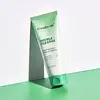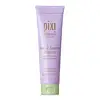What's inside
What's inside
 Key Ingredients
Key Ingredients

 Benefits
Benefits

 Concerns
Concerns

 Ingredients Side-by-side
Ingredients Side-by-side

Water
Skin ConditioningGlycerin
HumectantPalmitic Acid
EmollientLauric Acid
CleansingStearic Acid
CleansingMyristic Acid
CleansingPotassium Hydroxide
BufferingCocamidopropyl Betaine
CleansingPEG-100 Stearate
Glyceryl Stearate
EmollientBeeswax
Emulsion StabilisingGlycol
HumectantEthylhexylglycerin
Skin ConditioningPolyquaternium-10
Capric Acid
CleansingDisodium EDTA
Aloe Barbadensis Leaf Extract
EmollientOryza Sativa Extract
AbsorbentCamellia Sinensis Leaf Extract
Antimicrobial1,2-Hexanediol
Skin ConditioningHydrogenated Lecithin
EmulsifyingPolyglyceryl-10 Stearate
Skin ConditioningLilium Tigrinum Root Extract
HumectantPanthenol
Skin ConditioningSodium Hyaluronate
HumectantSodium Ascorbyl Phosphate
AntioxidantHydroxypropyltrimonium Hyaluronate
Niacinamide
SmoothingHydrolyzed Hyaluronic Acid
HumectantPyridoxine
Skin ConditioningFolic Acid
Skin ConditioningSodium Acetylated Hyaluronate
HumectantBiotin
AntiseborrhoeicHyaluronic Acid
HumectantHydrolyzed Sodium Hyaluronate
Skin ConditioningTocopherol
AntioxidantSodium Hyaluronate Crosspolymer
HumectantCyanocobalamin
Skin ConditioningPotassium Hyaluronate
Skin ConditioningThiamine Hcl
MaskingBeta-Carotene
Skin ConditioningRiboflavin
Cosmetic ColorantLinoleic Acid
CleansingParfum
MaskingWater, Glycerin, Palmitic Acid, Lauric Acid, Stearic Acid, Myristic Acid, Potassium Hydroxide, Cocamidopropyl Betaine, PEG-100 Stearate, Glyceryl Stearate, Beeswax, Glycol, Ethylhexylglycerin, Polyquaternium-10, Capric Acid, Disodium EDTA, Aloe Barbadensis Leaf Extract, Oryza Sativa Extract, Camellia Sinensis Leaf Extract, 1,2-Hexanediol, Hydrogenated Lecithin, Polyglyceryl-10 Stearate, Lilium Tigrinum Root Extract, Panthenol, Sodium Hyaluronate, Sodium Ascorbyl Phosphate, Hydroxypropyltrimonium Hyaluronate, Niacinamide, Hydrolyzed Hyaluronic Acid, Pyridoxine, Folic Acid, Sodium Acetylated Hyaluronate, Biotin, Hyaluronic Acid, Hydrolyzed Sodium Hyaluronate, Tocopherol, Sodium Hyaluronate Crosspolymer, Cyanocobalamin, Potassium Hyaluronate, Thiamine Hcl, Beta-Carotene, Riboflavin, Linoleic Acid, Parfum
Water
Skin ConditioningEthylhexyl Palmitate
EmollientCetyl Ethylhexanoate
EmollientMethylpropanediol
SolventGlycerin
Humectant1,2-Hexanediol
Skin ConditioningCetearyl Alcohol
EmollientPolysorbate 60
EmulsifyingGlyceryl Stearate
EmollientPalmitic Acid
EmollientHydroxyethyl Acrylate/Sodium Acryloyldimethyl Taurate Copolymer
Emulsion StabilisingRetinyl Palmitate
Skin ConditioningArachis Hypogaea Flour
AbrasiveHelianthus Annuus Seed Oil
EmollientJasminum Officinale Oil
MaskingRubus Fruticosus Fruit Extract
AstringentBuddleja Davidii Extract
Skin ConditioningThymus Vulgaris Extract
PerfumingCeramide NP
Skin ConditioningTocopherol
AntioxidantCarbomer
Emulsion StabilisingCaprylic/Capric Triglyceride
MaskingSorbitan Stearate
EmulsifyingCetearyl Olivate
Sorbitan Olivate
EmulsifyingSodium Magnesium Silicate
Behenyl Alcohol
EmollientDipropylene Glycol
HumectantPotassium Hydroxide
BufferingHydrogenated Lecithin
EmulsifyingEthylhexylglycerin
Skin ConditioningDisodium EDTA
Water, Ethylhexyl Palmitate, Cetyl Ethylhexanoate, Methylpropanediol, Glycerin, 1,2-Hexanediol, Cetearyl Alcohol, Polysorbate 60, Glyceryl Stearate, Palmitic Acid, Hydroxyethyl Acrylate/Sodium Acryloyldimethyl Taurate Copolymer, Retinyl Palmitate, Arachis Hypogaea Flour, Helianthus Annuus Seed Oil, Jasminum Officinale Oil, Rubus Fruticosus Fruit Extract, Buddleja Davidii Extract, Thymus Vulgaris Extract, Ceramide NP, Tocopherol, Carbomer, Caprylic/Capric Triglyceride, Sorbitan Stearate, Cetearyl Olivate, Sorbitan Olivate, Sodium Magnesium Silicate, Behenyl Alcohol, Dipropylene Glycol, Potassium Hydroxide, Hydrogenated Lecithin, Ethylhexylglycerin, Disodium EDTA
Ingredients Explained
These ingredients are found in both products.
Ingredients higher up in an ingredient list are typically present in a larger amount.
1,2-Hexanediol is a synthetic liquid and another multi-functional powerhouse.
It is a:
- Humectant, drawing moisture into the skin
- Emollient, helping to soften skin
- Solvent, dispersing and stabilizing formulas
- Preservative booster, enhancing the antimicrobial activity of other preservatives
Disodium EDTA plays a role in making products more stable by aiding other preservatives.
It is a chelating agent, meaning it neutralizes metal ions that may be found in a product.
Disodium EDTA is a salt of edetic acid and is found to be safe in cosmetic ingredients.
Learn more about Disodium EDTAEthylhexylglycerin (we can't pronounce this either) is commonly used as a preservative and skin softener. It is derived from glyceryl.
You might see Ethylhexylglycerin often paired with other preservatives such as phenoxyethanol. Ethylhexylglycerin has been found to increase the effectiveness of these other preservatives.
Glycerin is already naturally found in your skin. It helps moisturize and protect your skin.
A study from 2016 found glycerin to be more effective as a humectant than AHAs and hyaluronic acid.
As a humectant, it helps the skin stay hydrated by pulling moisture to your skin. The low molecular weight of glycerin allows it to pull moisture into the deeper layers of your skin.
Hydrated skin improves your skin barrier; Your skin barrier helps protect against irritants and bacteria.
Glycerin has also been found to have antimicrobial and antiviral properties. Due to these properties, glycerin is often used in wound and burn treatments.
In cosmetics, glycerin is usually derived from plants such as soybean or palm. However, it can also be sourced from animals, such as tallow or animal fat.
This ingredient is organic, colorless, odorless, and non-toxic.
Glycerin is the name for this ingredient in American English. British English uses Glycerol/Glycerine.
Learn more about GlycerinGlyceryl Stearate is a mix of glycerin and stearic acid.
It is used to stabilize the mixing of water and oil ingredients. By preventing these ingredients from separating, it can help elongate shelf life. It can also help thicken the product's texture.
As an emollient, it helps soften skin and supports barrier-replenishing ingredients.
In cosmetics, Glyceryl Stearate is often made from vegetable oils or synthetically produced.
This ingredient may not be fungal-acne safe
Fun fact: The human body also creates Glyceryl Stearate naturally.
Learn more about Glyceryl StearateHydrogenated Lecithin is created from the hydrogenation of lecithin (a group of phospholipids). Hydrogenation is a chemical reaction between hydrogen and another element.
This ingredient is an emollient and emulsifier. As an emollient, it helps soften skin by trapping moisture within. As an emulsifier, it prevents oil and water ingredients from separating.
Palmitic Acid is a fatty acid naturally found in our skin and in many plant and animal sources. In cosmetics, it is usually derived from palm oil. It serves many purposes in skincare, acting as a cleanser, emollient, and emulsifier.
As an emollient, palmitic acid helps soften and smooth the skin by preventing water loss. In cleansers, it helps remove oil and dirt while creating foam.
Its emulsifying properties help stabilize products by keeping water and oil-based ingredients from separating.
This may not be suitable for fungal acne-prone skin, as fatty acids like this can sometimes trigger breakouts in sensitive individuals.
Learn more about Palmitic AcidPotassium hydroxide is commonly known as caustic potash. It is used to fix the pH of a product or as a cleaning agent in soap. In cleansers, it is used for the saponification of oils.
Sapnification is the process of creating fatty acid metal salts from triglycerides and a strong base. During this process, Potassium Hydroxide is used up and is not present in the final product.
Using high concentrations of Potassium Hydroxide have shown to irritate the skin.
Learn more about Potassium HydroxideTocopherol (also known as Vitamin E) is a common antioxidant used to help protect the skin from free-radicals and strengthen the skin barrier. It's also fat soluble - this means our skin is great at absorbing it.
Vitamin E also helps keep your natural skin lipids healthy. Your lipid skin barrier naturally consists of lipids, ceramides, and fatty acids. Vitamin E offers extra protection for your skin’s lipid barrier, keeping your skin healthy and nourished.
Another benefit is a bit of UV protection. Vitamin E helps reduce the damage caused by UVB rays. (It should not replace your sunscreen). Combining it with Vitamin C can decrease sunburned cells and hyperpigmentation after UV exposure.
You might have noticed Vitamin E + C often paired together. This is because it is great at stabilizing Vitamin C. Using the two together helps increase the effectiveness of both ingredients.
There are often claims that Vitamin E can reduce/prevent scarring, but these claims haven't been confirmed by scientific research.
Learn more about TocopherolWater. It's the most common cosmetic ingredient of all. You'll usually see it at the top of ingredient lists, meaning that it makes up the largest part of the product.
So why is it so popular? Water most often acts as a solvent - this means that it helps dissolve other ingredients into the formulation.
You'll also recognize water as that liquid we all need to stay alive. If you see this, drink a glass of water. Stay hydrated!
Learn more about Water